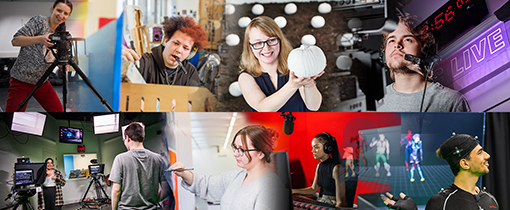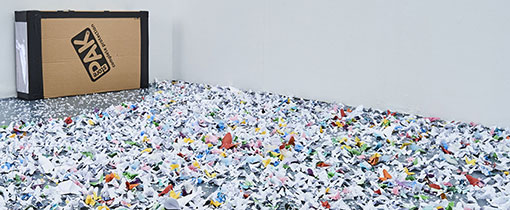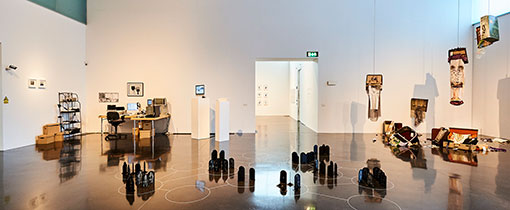
Print Support Hub
School of Creative Industries / Facilities / Print Support Hub
The worlds industry of printing continues to evolve with new techniques and advances in technology. Our School offers the earliest means of printing using traditional analogue presses alongside the most cutting-edge digital outputting devices. Often using a combination of analogue and digital can provide a finish that cannot be created any other way.
The Print Support Hub in room Mk312 (3rd Floor), like the traditional printing workshops on the ground floor, is a technically supported, open access area. It offers all School of Art students a range of specialist printers that are capable of printing onto a vast array of different materials.
In Focus
Learn about the Print Support Hub in more detail
Including technical support, demonstrations and specialist printers and finishing equipment.
Jim Abernethy is Principal Technician, overseeing the operation of both traditional and digital print areas, and offers a wealth of experience having worked in the printing industry and as a fine art printer himself. Jim has worked in the School of Art for over twenty years.
The university recognises that the student experience is often restricted by additional expenditures so this workshop is subsidised by the School to offer creative students an affordable place to output their digital files. This financial benefit is extended so that students, whilst being inducted to the printers, are not charged for their prints.
The technicians in the Print Support Hub (PSH) offer demonstrations on how to get the best results from your artwork. If you are designing/creating files for printing, it is often the prepress preparation of those files that can be overlooked. This can make a huge difference to the finished results, whether your files are the right resolution, colour mode, or saved in the correct format for each particular printer. The lines or dots per inch, and screen angles all determine the way in which an artwork will reproduce.
Many modules require students to create images using spot colours or duotones, as opposed to the standard CMYK. Technical support will demonstrate how to mix different printing techniques using our specialist inks, the results broaden the visual colour palette and the tactile properties of the finished artwork.
Though each of our printers has its inherent limitations such as type of inks used or the coatings applied to papers/fabrics, we are happy to explore and experiment with these creative boundaries whilst using experience as a buffer. We have printed directly onto wallpapers and metal sheeting, even used inks that change colour with temperature or carry an electric current. We have recently supported a student who ground 112 million year old dinosaur bones into a fine paste for printing. Please approach us if you have an idea, do not let conventional means of printing be your limitation!
Some of the printers and finishing equipment available from the Print Support Hub...
- The A3 Risograph printer, often shortened to ‘Riso’ is fundamentally a mechanised form of screen-printing, but can print two colours simultaneously. It will print with predefined spot coloured inks rather than the conventional cyan, yellow, magenta and black (CMYK). We have fluorescent pink/orange and a gold ink that add a wider colour spectrum to standard inks. Instead of a mesh attached to a conventional flat silkscreen frame, it uses a drum with an integrated screen mesh. The ‘Master-Making Media’ is then wrapped around the mesh to form a temporary resist. This material is derived from banana hemp, and the inks are made from soya, so has the added benefit of being environmentally friendly. We also stock a broad colour range of FSC (has been harvested in a responsible manner) papers.
- We offer two medium format high-end Epson printers (A4, A3, A3+ and A2) that output onto a range of Matt, Lustre and Gloss 271gsm photographic papers. This range extends onto one of our two large format Epson printers, enabling you to scale up artwork to 150cm wide and to an infinite length. The inks from these printers are rated as archival quality, i.e. are guaranteed not to colour-shift for 75 years. This enables students to exhibit and sell their work at a professional level, unlike many external commercial printers where cheap formula replica inks are used.
- We also offer a range of specialist papers. These include heavyweight Hahnemühle fine art papers, photo-board, canvases, acetates, vinyls, sticky-backed media, chrome mirrored finish, box-card etc. If there is a specific media you would like to print onto, we can usually accommodate. The school Art Shop stocks a huge range of paper and boards in different weights and colour.
- We have a large format thermal lithographic printer (3ft wide to infinite length). This printer facilitates and bridges a digitally generated image with the more traditional means of printing. It will output either a ‘positive’ or a ‘negative’ film, depending on the intended printing process to be used. It has a thermal strip which burns the image into the heat sensitive photographic film. This versatile media can be used as a photographic negative because the density of black is sufficient enough to act as a UV resist. The film can therefore be assigned to many printing processes. It is used to transfer images onto silk-screen, or will create a photo etching or emboss from a metal plate when using the etching presses. In the darkrooms, it can be used as a resist for Photograms or Bichromate printing. The printer can also burn onto a lightweight thermally sensitive paper.
- The large format Epson textile printer uses dye sublimation inks onto heat transfer media, this is then transferred onto the fabric surface using specialist presses. We keep in stock a large range of fabrics, the printers versatility will also enable you to transfer your image onto some rigid substrates.
The Roland Print & Cut SG2-300 uses Eco Solvent Inks onto Monomeric or Polymeric rolls of vinyl media (up to 30” wide and an infinite length). These are sticky backed vinyl that, after being printed, will then cut the user’s predefined path through the vinyl surface, leaving the backing intact. This generates cut out stickers that can be transferred onto a wide range of surfaces. We keep in stock gloss/matt finish vinyl, along with one-way vision and semi opaque frosted media, each offering a visually different effect to use as is, or to overlay onto other artwork. - The vinyl is often used as a resist for sandblasting ceramics, metals, glass or plastics.
We also stock a heat transferable media for cotton fabrics.
We have a dedicated A4 decal printer that will transfer your images onto either glass or a range of ceramic finishes. When using the appropriate 'cover-coat' the inks can withstand exposure to the high temperatures from our specialist kilns. - The A3+ laser printer is a duplex machine. (will print onto both sides). We stock a range of weights of paper, it will also print banners.
- The room offers two large format scanners that will scan artwork up to A0 size.
There are two large format guillotines, one electric for large paper prints, the other to cut thicker materials such as mount-board and foam-board.


/prod01/wlvacuk/media/departments/digital-content-and-communications/images-2024/Simmi-Sahota-degreeshow-thumbnail.png)
/prod01/wlvacuk/media/departments/digital-content-and-communications/images-2024/250630-SciFest-1-group-photo-resized-800x450.png)
/prod01/wlvacuk/media/departments/digital-content-and-communications/images-18-19/210818-Iza-and-Mattia-Resized.jpg)
/prod01/wlvacuk/media/departments/digital-content-and-communications/images/Maria-Serria-(teaser-image).jpg)
/prod01/wlvacuk/media/departments/digital-content-and-communications/images-2024/241014-Cyber4ME-Project-Resized.jpg)
/prod01/wlvacuk/media/departments/digital-content-and-communications/images-18-19/210705-bric_LAND_ATTIC_v2_resized.jpg)
/prod01/wlvacuk/media/departments/faculty-of-arts/images/banners/digital_printmaking_facilities_banner_01.jpg)
/prod01/channel_25/media/departments/faculty-of-arts/images/facilities-images/print-support-hub/Print-Support-Hub-Thumb-1.jpg)
/prod01/channel_25/media/departments/faculty-of-arts/images/facilities-images/print-support-hub/Print-Support-Hub-Thumb-2.jpg)
/prod01/channel_25/media/departments/faculty-of-arts/images/facilities-images/print-support-hub/Print-Support-Hub-Thumb-3.jpg)

